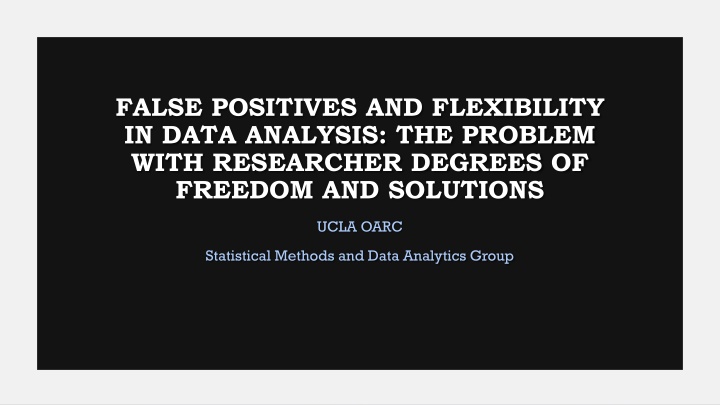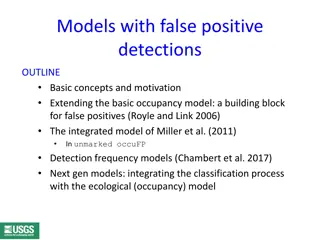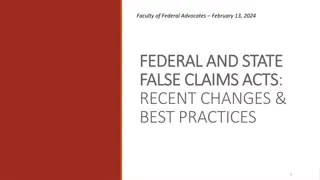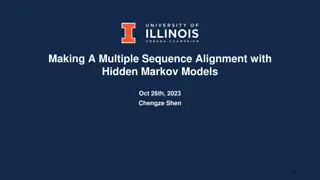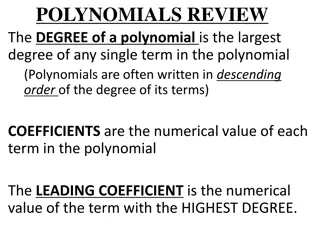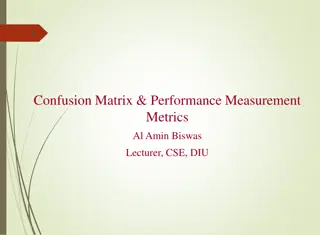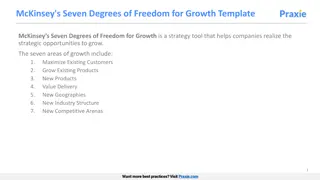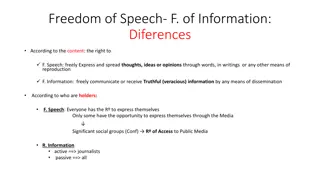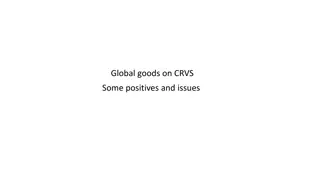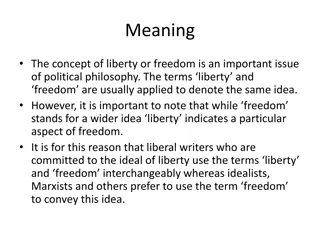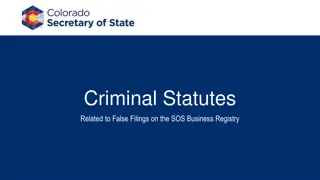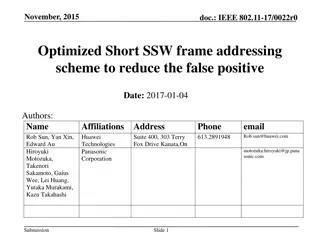False Positives and Flexibility in Data Analysis: Addressing Researcher Degrees of Freedom
This content delves into the issue of false positives in data analysis, emphasizing how researcher degrees of freedom can lead to erroneous conclusions. It discusses the impact of hypothesis tests, p-values, and the prevalence of false positives in research. Solutions such as setting simple rules for authors and reviewers and incorporating multiverse analysis are proposed to mitigate these issues. The consequences of false positives, including the replication crisis in research, are also highlighted.
Download Presentation

Please find below an Image/Link to download the presentation.
The content on the website is provided AS IS for your information and personal use only. It may not be sold, licensed, or shared on other websites without obtaining consent from the author.If you encounter any issues during the download, it is possible that the publisher has removed the file from their server.
You are allowed to download the files provided on this website for personal or commercial use, subject to the condition that they are used lawfully. All files are the property of their respective owners.
The content on the website is provided AS IS for your information and personal use only. It may not be sold, licensed, or shared on other websites without obtaining consent from the author.
E N D
Presentation Transcript
FALSE POSITIVES AND FLEXIBILITY IN DATA ANALYSIS: THE PROBLEM WITH RESEARCHER DEGREES OF FREEDOM AND SOLUTIONS UCLA OARC Statistical Methods and Data Analytics Group
OUTLINE Background on hypothesis tests, p-values and false positives An argument of why current practices encourage researchers to find false positives1 Simulations that show how researcher degrees of freedom directly increase the false positive rate1 Solution: simple rules for authors and reviewers1 Solution: multiverse analysis2 1Simmons, J. P., Nelson, L. D., & Simonsohn, U. (2011). False-positive psychology: Undisclosed flexibility in data collection and analysis allows presenting anything as significant. Psychological Science, 22(11), 1369-1366. 2Steegen, S., Tuerlinckx, F., Gelman, A., & Vanpaemel, W. (2016). Increasing transparency through a multiverse analysis. Perspectives on Psychological Science, 11(5), 702-712.
HYPOTHESIS TESTS AND P-VALUES Null hypothesis testing is a widely used to tool for statistical inference ?0:? = 0 ??:? 0 Null hypotheses very commonly assert that a parameter of interest is zero in the population ?-values quantify the compatibility of the null with the data (Greenland et al., 2016) ?-values are typically used to decide whether or not to reject the null Rejection of the null is then used to infer an association or effect
FALSE POSITIVES A false positive results when a true null hypothesis is incorrectly rejected Usually because ? < 0.05 False positives often to lead to erroneous inferences that effects exist False positives occur because of: Mis-specified model Model assumptions are violated (Greenland et al., 2016) Chance!
THE PROBLEM WITH FALSE POSITIVES False positives are costly errors Published results, including false positives, inform new research and hypotheses Garbage in garbage out, a waste of resources They persist in the literature Failures to replicate the false positive (reject the null again) can be attributed to many causes Different subjects, different setting, Journals often do not publish replication studies, so little incentive to re-assess a false positive result Once discovered, credibility loss to researchers and the field as a whole
FALSE POSITIVES AND THE REPLICATION CRISIS A 2015 large-scale study (Open Science Collaboration, 2015) attempted to replicate 100 published psychology studies using high-powered designs Only 36% of replications had significant results (vs 97% of original studies) 82.8% replications showed smaller effect sizes than original False positives reported in original studies are believed to be a major reason for inability to replicate From Open Science Collaboration (2015)
WHY CURRENT PRACTICES ENCOURAGE RESEARCHERS TO FIND FALSE POSITIVES
Journals incentivize researchers to report statistically significant results. Shun non-significant results And replication studies Researchers often don t know what data processing and analysis decisions are best Many decisions seem arbitrary Data don t always arrive as expected
Journals incentivize researchers to report statistically significant results ? = .02 ? = .17 ? = .24 ? = .32 ? = .41 ? = .11 ? = .06 ? = .09 Researchers run many tests with many versions of the data to find a significant result More tests mean more opportunities for false positives Researchers often don t know what data processing and analysis decisions are best
? =.?? The best result is published without mention of the other results Journals do not require disclosure Researchers self-justify decisions Journals incentivize researchers to report statistically significant results ? = .41 ? = .17 ? = .09 ? = .32 ? = .24 Researchers run many tests with many versions of the data to find a significant result ? = .06 ? = .11 Researchers often don t know what data processing and analysis decisions are best The bad results are discarded into the file drawer Creates a publication bias
? =.?? The best result is published without mention of the other results Journals incentivize researchers to report statistically significant results ? = .41 ? = .17 ? = .09 ? = .32 ? = .24 Researchers run many tests with many versions of the data to find a significant result ? = .06 ? = .11 Researchers often don t know what data processing and analysis decisions are best The bad results are discarded into the file drawer
POLL Have you ever been involved in a study where a single result was reported instead of reporting that...(click all that apply) a model/test was run more than once, after additional data were collected? data collection was stopped because a desired model/test result was found? observations were excluded after examining model/test results and the analysis was run again? the same model/test was run on several related outcomes? the same model/test was run on various transformations of the outcome? the same model/test was run after combining some groups together?
RESEARCHER DEGREES OF FREEDOM (RDF) Data usually need to be processed prior to analysis Researcher degrees of freedom: data processing options that result in alternative versions of the data Often, decisions seem arbitrary with ambiguity in best choices Not usually used to deceive but to find (perhaps unconsciously) a significant result Researcher degrees of freedom become a problem when they are not disclosed
EXAMPLE RESEARCHER DEGREES OF FREEDOM Changing sample sizes Collect more data (often justified that smaller sample size is underpowered to detect effect) Remove some observations Exclusion due to missing data Operationalizing analysis variables Combining categories Discretizing continuous variables Combining variables (e.g. means, scales) Variable transformations Which variables need to be included in model?
OUTLIERS EXAMPLE Authors perused 30 Psychological Science articles analyzing reaction time Most studies excluded some responses for being too fast or too slow Reponses that are too slow may reflect lapses in attention But definition of too fast varied: Top 2.5% > 2 standard deviations from mean Faster than 100, 150, 200, or 300 ms Too slow also varied: Lowest 2.5% or 10% < 2, 2.5 or 3 standard deviations from mean Slower than 1,000, 1,200, 1,500, 2,000, 3,000, or 5,000 ms None of these is wrong , but their variance suggests self-justified usage of researcher degrees of freedom
SIMULATING HOW RESEARCHER DEGREES OF FREEDOM INCREASE THE FALSE POSITIVE RATE
SIMULATING A TRUE EFFECT Normally, to simulate a true effect of ?, we would draw random values from 2 or more distributions which differ in their means The random values are called ? here A significant difference in means detected by a ?-test would be a true positive Fig. 1 Drawing samples from two populations
SIMULATING A FALSE POSITIVE: STEP 1 However, here we want to simulate false positives (no effect of ?) So, we will instead draw 20 ? values from a single normal distribution Fig. 2 Drawing samples from one population
SIMULATING A FALSE POSITIVE: STEP 2 Then we will randomly assign 10 ? values to ? = 0, and the other 10 to ? = 1 Fig. 3 Randomly assigning samples from the same population to two different groups
SIMULATING A FALSE POSITIVE: STEP 3 Then, we test for differences in the mean value of ? between ? = 0 and ? = 1 with a t-test and record the p-value A significant difference (i.e. ? < 0.05) between samples detected by a ?-test would be a false positive Fig. 4 Comparing means between 2 groups from the same population
SIMULATING A FALSE POSITIVE: REPEAT STEPS MANY TIMES We repeat this process ? times (e.g. 1,000), and record the ?-value for each simulation We should have ??-values when finished When the null is true, ?-values have a uniform distribution (all values equally likely) Because the null hypothesis is true here, we should expect 5% of ?-values to be less than 0.05 Fig. 5 Repeating the simulation many times
SIMULATING THE EFFECT OF RDF ON THE FALSE POSITIVE RATE, SCENARIO A Scenario A We draw 20 pairs of ? from 2 correlated distributions, call one distribution ?1 and the other ?2 Then randomly assign ? = 0 to 10 pairs and ? = 1 to the other 10 pairs Run a t-test on ?1, ?2, and ?1+?2 minimum p-value , record the 2 Repeat the above steps many times Simulates choosing between outcomes, or a combination Fig. 6 Scenario A: Drawing correlated sample pairs from two distributions and randomly assigning pairs to two groups
SIMULATING THE EFFECT OF RDF ON THE FALSE POSITIVE RATE, SCENARIO B Scenario B: Draw 20 ? from single distribution, assign ? = 0 to random 10, ? = 1 to other 10 Run t-test If ? > 0.05, draw 10 more ?, randomly assign 5 to ? = 0, other 5 to ? = 1 Run t-test again Repeat many times Fig. 7 Testing at ? = 20; if ? > 0.05, add ten observations and test again.
TWO MORE SCENARIOS Scenario C: using covariates testing for Condition effect in ANCOVA with either: no covariate or gender or gender*Condition interaction Significance achieved if either main effect of Condition or gender*Condition interaction was significant Scenario D: reporting subsets of condition comparisons assign 3 conditions test all 3 pairwise contrasts and linear trend (4 tests)
SIMULATION RESULTS Each situation raises the probability of at least one false positive to above .05 Combining all of these researcher degrees of freedom (choices) leads to greater than .5 chance of false positive! None of these are commonly flagged as problematic in reviews! Researchers are likely using many more researcher degrees of freedom than A,B,C, and D combined Table 1 from Simmons et al. (2011)
SPOT WHERE RESEARCHER DEGREES OF FREEDOM MIGHT HAVE BEEN USED Assessing fertility. [W]e created a high-fertility group (cycle days 7 14, n = 78) and a low fertility group (cycle days 17 25, n = 85)...[W]e did not include women on cycle days 15 and 16 because of the difficulty of determining fertility status on these days ...We also did not include women at the beginning of the ovulatory cycle (cycle days 1 6) or at the end of the ovulatory cycle (cycle days 26 28) to avoid potential confounds due to premenstrual or menstrual symptoms. Relationship status. Participants indicated their current relationship status by selecting one of the following five descriptions: not currently dating or romantically involved with anyone (24.7%), dating (20.0%), engaged or living with my partner (23.2%), married (31.3%), or other (0.7%) [P]articipants who indicated that they were engaged, living with a partner, or married were classified as being in a committed relationship (n = 82); all others (e.g., not dating or dating) were classified as single (n = 81).
SOLUTIONS: SIMPLE RULES FOR AUTHORS AND REVIEWERS From Simmons, Nelson & Simonsohn (2011)
SOLUTIONS: REQUIREMENTS FOR AUTHORS 1. Determine data collection termination rule before data collection and report the rule Most important: Determining rule before looking at data Adhering to it Reporting it 2. Collect at least 20 observations per cell Can report power calculations 3. List all variables collected Or disclose more arbitrary rules based on other factors We decided to collect 50 observations based on subject availability and time constraints 4. Report all experimental conditions 5. Report results that include excluded observations 6. Report analyses excluding covariates
SOLUTIONS: REQUIREMENTS FOR AUTHORS 1. Determine data collection termination rule before data collection and report the rule Only the largest effects can be reliably detected with ? < 20 Smaller sample sizes may indicate violation of Rule 1 2. Collect at least 20 observations per cell If impossible, justify smaller samples with compelling reasons Costs Small population size 3. List all variables collected 4. Report all experimental conditions 5. Report results that include excluded observations 6. Report analyses excluding covariates
SOLUTIONS: REQUIREMENTS FOR AUTHORS 1. Determine data collection termination rule before data collection and report the rule Allows reviewer to assess flexibility in choosing which variables enter models Outcomes Covariates 2. Collect at least 20 observations per cell Use only to indicate list is exhaustive Respondents reported only the following: age, gender, and income. 3. List all variables collected 4. Report all experimental conditions 5. Report results that include excluded observations 6. Report analyses excluding covariates
SOLUTIONS: REQUIREMENTS FOR AUTHORS 1. Determine data collection termination rule before data collection and report the rule Prevents selective reporting of comparisons that produce results that agree with researcher hypotheses Don t report just A vs B comparison if you also had a C condition 2. Collect at least 20 observations per cell Use only to indicate exhaustive list of conditions 3. List all variables collected 4. Report all experimental conditions 5. Report results that include excluded observations 6. Report analyses excluding covariates
SOLUTIONS: REQUIREMENTS FOR AUTHORS 1. Determine data collection termination rule before data collection and report the rule Allows assessment of sensitivity of results to exclusion of observations Encourages authors to justify exclusions 2. Collect at least 20 observations per cell 3. List all variables collected 4. Report all experimental conditions 5. Report results that include excluded observations 6. Report analyses excluding covariates
SOLUTIONS: REQUIREMENTS FOR AUTHORS 1. Determine data collection termination rule before data collection and report the rule Similar to Rule 5, allows assessment of sensitivity of results to inclusion of covariates 2. Collect at least 20 observations per cell Encourages justification of covariate inclusion 3. List all variables collected 4. Report all experimental conditions 5. Report results that include excluded observations 6. Report analyses excluding covariates
SOLUTION: GUIDELINES FOR REVIEWERS 1. Ensure that authors follow requirements Reviewers have the power to change reporting standards 2. Be more tolerant of imperfect results Prioritize transparency over tidiness If a perfect results came from the use of researcher degrees of freedom, they must be reported 3. Require authors to show that results do not depend on arbitrary decisions 4. If justifications for data processing choices are not compelling, require a replication
SOLUTION: GUIDELINES FOR REVIEWERS 1. Ensure that authors follow requirements Researchers use their degrees of freedom because of the pressure to produce perfect (i.e. significant) results 2. Be more tolerant of imperfect results Reviewers should be skeptical of underpowered studies with perfect results 3. Require authors to show that results do not depend on arbitrary decisions 4. If justifications for data processing choices are not compelling, require a replication
SOLUTION: GUIDELINES FOR REVIEWERS 1. Ensure that authors follow requirements Request robustness checks Require consistency of decisions across experiments/studies 2. Be more tolerant of imperfect results 3. Require authors to show that results do not depend on arbitrary decisions 4. If justifications for data processing choices are not compelling, require a replication
SOLUTION: GUIDELINES FOR REVIEWERS 1. Ensure that authors follow requirements Replication is costly, but sometimes necessary 2. Be more tolerant of imperfect results 3. Require authors to show that results do not depend on arbitrary decisions 4. If justifications for data processing choices are not compelling, require a replication
SOLUTION: MULTIVERSE ANALYSIS From Steegen, Tuerlincx, Gelman, and Vanpaemel (2016)
MULTIVERSE ANALYSIS In preparing raw data for analysis, using researcher degrees of freedom produces not one unique data set but many alternate versions A multiverse of data sets A multiverse of data sets yields a multiverse of statistical results
We begin with a single raw data set. Data processing decisions will result in alternative versions. raw
Decision 1: how to exclude based on age: over 70 or over 50? exclude age>70 raw exclude age>50
Decision 2: How to use the BMI variable as an independent variable: continuous, 3-category or 5- category? exclude age>70; cont. bmi exclude age>50; 5-cat bmi exclude age>70; 3-cat bmi raw exclude age>70; 5-cat bmi exclude age>50; 3-cat bmi exclude age>50; cont bmi
Decision 3: How to transform the dependent variable: square root or log? exclude age>70; cont. bmi; DV sqrt exclude age>50; 5-cat bmi; DV log exclude age>70; cont. bmi; DV log exclude age>50; 5-cat bmi; DV sqrt exclude age>70; 3-cat bmi; DV sqrt exclude age>50; 3-cat bmi; DV log exclude age>70; 3-cat bmi; DV log raw exclude age>50; 3-cat bmi; DV sqrt exclude age>70; 5-cat bmi; DV sqrt exclude age>50; cont bmi; DV log exclude age>70; 5-cat bmi; DV log exclude age>50; cont bmi; DV sqrt
Each of the 12 data sets in this multiverse is a unique combination of these 3 decisions. exclude age>70; cont. bmi; DV sqrt exclude age>50; 5-cat bmi; DV log exclude age>70; cont. bmi; DV log exclude age>50; 5-cat bmi; DV sqrt exclude age>70; 3-cat bmi; DV sqrt Because many decisions are arbitrary, it s not clear which data set is best to use exclude age>50; 3-cat bmi; DV log exclude age>70; 3-cat bmi; DV log raw exclude age>50; 3-cat bmi; DV sqrt exclude age>70; 5-cat bmi; DV sqrt exclude age>50; cont bmi; DV log exclude age>70; 5-cat bmi; DV log exclude age>50; cont bmi; DV sqrt
p=.18 p=.07 p=.32 The same hypothesis may be tested in many or all versions of the data, resulting in a multiverse of statistical results. exclude age>70; cont. bmi; DV sqrt exclude age>50; 5-cat bmi; DV log exclude age>70; cont. bmi; DV log p=.24 p=.10 exclude age>50; 5-cat bmi; DV sqrt exclude age>70; 3-cat bmi; DV sqrt exclude age>50; 3-cat bmi; DV log exclude age>70; 3-cat bmi; DV log raw p=.07 p=.01 exclude age>50; 3-cat bmi; DV sqrt exclude age>70; 5-cat bmi; DV sqrt p=.15 p=.22 exclude age>50; cont bmi; DV log exclude age>70; 5-cat bmi; DV log exclude age>50; cont bmi; DV sqrt p=. 03 p=.12 p=.32
p=.18 p=.07 p=.32 However, results are often presented as if only one of the data sets was analyzed. exclude age>70; cont. bmi; DV sqrt exclude age>50; 5-cat bmi; DV log exclude age>70; cont. bmi; DV log p=.24 p=.10 exclude age>50; 5-cat bmi; DV sqrt exclude age>70; 3-cat bmi; DV sqrt exclude age>50; 3-cat bmi; DV log exclude age>70; 3-cat bmi; DV log raw p=.07 p=.01 exclude age>50; 3-cat bmi; DV sqrt exclude age>70; 5-cat bmi; DV sqrt p=.15 p=.22 exclude age>50; cont bmi; DV log exclude age>70; 5-cat bmi; DV log exclude age>50; cont bmi; DV sqrt p=. 03 p=.12 p=.32
MULTIVERSE ANALYSIS: EVERYTHING EVERYWHERE ALL AT ONCE Selectively reporting the result from a single data set from a data multiverse obscures the sensitivity of the result to the data processing decisions Multiverse analysis is running the same analyses across all data sets in the multiverse and presenting all results Reveals number of data sets analyzed Allows assessment of robustness of results to data processing choices To demonstrate, Steegen et al. (2016) performed a multiverse analysis of data used for a study of how fertility and relationship status interact to affect religiosity and political preferences, by Durante et al. (2013)
MULTIVERSE ANALYSIS OF DURANTE ET AL. (2013) Durante et al. (2013) conducted two studies with two different raw data sets Durante et al. (2013) claimed to find in Study 1 A Relationship status Fertility interaction in predicting religiosity Single women who were high-fertility were less religious, opposite for women in relationship Fig. 1 from Durante et al. (2013)
